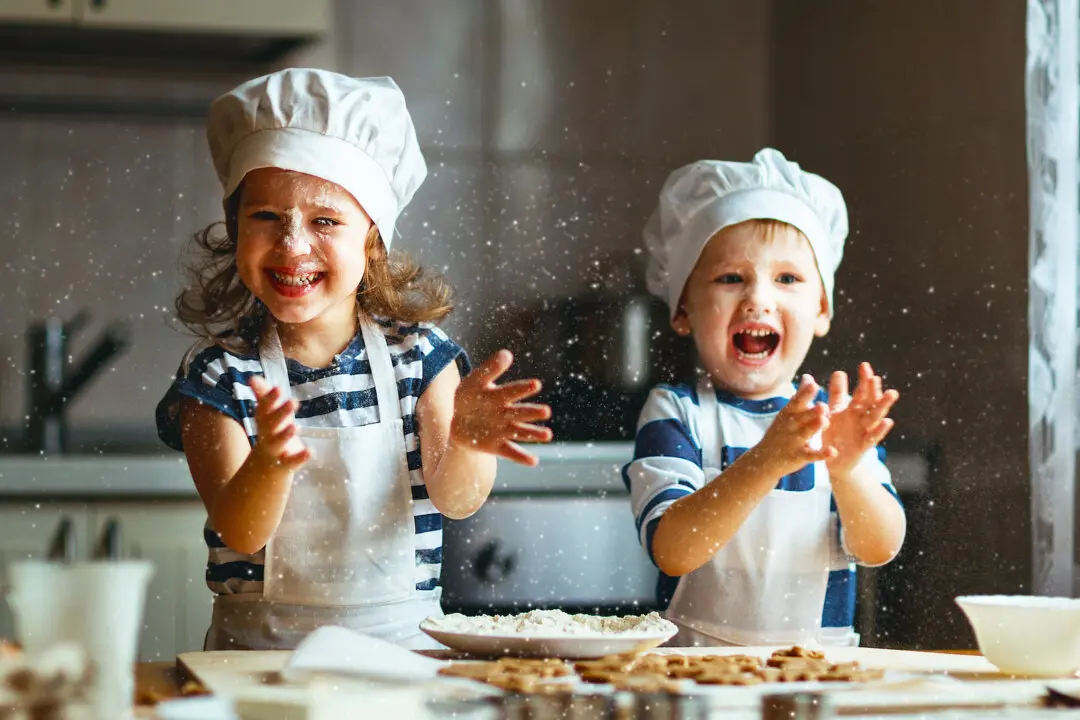PITTSBURGH—Any parent who’s gone through a “I don’t like that” phase knows that kids can be notoriously picky eaters, often because they’re more sensitive to smells, texture, and taste.
Children also can be afraid to try unfamiliar foods, which is why many experts advise teaching kids about where food comes from and how it’s prepared from a very early age.
Yet for reasons both big and small, getting youngsters into the kitchen can prove a significant challenge for today’s busy parents.
Jordan Welt of Ben Avon, Pennsylvania, is a classic example. The mother of 9-year-old Theo and kindergartner Violet would love to cook more with her children.
“It’s just our space is so small, and the amount of mess,” she says. “It blows up our kitchen.”
Time is an even bigger issue. Between sports, schoolwork, jobs, and other activities, parents and kids are busier than ever. As Welt puts it, “I’ve always got 100 things going on.”
Having little ones underfoot when you’ve got a hot pan of frying chicken or steaming pot or rice in hand only adds to the stress of mealtime.
Food journalist Mark Bittman feels Welt’s and every other parent’s pain and frustration.
While his two daughters learned to love good homemade food while they were growing up—the former New York Times columnist has written 30 cookbooks and spends many hours in the kitchen—he readily admits he could have done a better job of teaching them this all-important life skill when they were little.
“Sure I cooked with them, but I wasn’t as diligent as I should have been if I were was doing it all again,” he says on a recent phone call from Italy, where he was doing research for the Rome Sustainable Food Project.
Studies show that involving kids with meal prep not only exposes them to unfamiliar foods in a positive way but also increases their likelihood of trying new foods.
Kitchen work also helps with hand-eye coordination and fine-motor skills, and allows youngsters to practice their number skills in a fun way by counting out or measuring ingredients. And reading recipes out loud together can help build a kid’s vocabulary.
Just as important: Teaching kids to cook with good food helps ensure they will grow into adults who see the benefit of cooking and have healthful eating habits.
“Kids need to be encouraged, or dare I say forced to eat well,” Bittman says.
When we give into our kids’ whims by serving breakfast cereal as serious food or dish up spaghetti every night for dinner, “it’s at our own peril and really their peril,” he says. “If you want generations of healthy adults, you need generations of healthy kids.”
Bittman—whose “How to Cook Everything” series has sold more than 1 million copies and won a slew of awards—admits he’s not sure how he fell into a “good food world.” His mother cooked with little joy, he says, “and I grew up eating every bit of junk food in sight, and that breeds bad habits.”
Yet, in the last 20 years, his cookbooks filled with simple, straightforward recipes geared toward both starting and experienced cooks have become essential additions to the modern home kitchen.
So why did it take until his daughters were “practically middle-aged” for the grandfather of two to figure out how to empower kids in the kitchen?
Released in October, “Kids Cook Everything: Inspiration and Recipes for Making the Food You Love” (Harvest, $35) is written specifically with 8- to 12-year-olds in mind, with flexible, kid-friendly recipes, fun illustrations and cute “Did you know?” text bubbles that explain cooking techniques.
The book, which took two years to write with help from his daughter, Kate, who oversees content for his website and podcast, also includes photos of real kids cooking real recipes in their own kitchens.
“It really is cooking with kids,” Bittman says of the 100-plus recipes that include everything from breakfast favorites like pancakes and French toast to soup, noodles, main dishes, pizza, and sweet desserts.
Why did it take so long?
Most cookbooks strike a balance between what you suppose cooks know and what they don’t, and how they know it, he says. For this project, “we just couldn’t figure out what ‘cooking with kids’ meant?” Bittman says.
While he and recipe developer Kerri Conan assumed kids knew less than most adults, Bittman didn’t want the recipes to be dumbed down. He also didn’t want the book to sound preachy.
“The idea was not ‘Take this book and make us dinner,’” he says. “It’s more ‘Let’s look through this book together and find something to cook together.’”
Bittman is definitely onto something. When I shared his cookbook with Welt last week, 5-year-old Violet quickly decided she wanted to make French toast with her mom, while her brother honed in on a recipe for oven-roasted french fries. And yes, they made a bit of a mess with their mom, but boy did they have fun!
I had a similar reaction when I gave my 12-year-old grand-niece, Hannah Makar, a copy of “Rebel Girls Cook,” a beginning cookbook of 100 kid-tested recipes for adolescent girls from the creators of The New York Times bestseller “Good Night Stories for Rebel Girls.”
While she likes to bake, the sixth-grader is just not that into cooking, says her mom, Laura. But she does like to come up with “creations” when she can be coaxed into the kitchen, “and cookbooks definitely help so she can follow the steps.”
When asked what she'd like to make for the family, Hannah chose a hearty dish: a barbecue sauce-slathered pork tenderloin that would help hone her knife skills.
Watching kids like Hannah, Theo, and Violet have a go at cooking food they would love to eat, Bittman says, was one of the best parts of writing “Kids Cook Everything.”
“If you can make kids comfortable in the kitchen, they will cook when they grow up,” he says.
What was most surprising, he adds, is how many adults have told him they wished he’s do a similar book for them.
French Toast: Beginner
PG testedMakes 2 slices.
- 1 egg
- 1/3 cup milk
- 1 teaspoon sugar or a teeny pinch of salt (if you like)
- 2 slices white or whole wheat bread, each no more than 1-inch thick
- 1 tablespoon butter or vegetable oil, plus more as needed
Whisk with a fork until the mixture—called a custard—is a light yellow color without streaks.
Set the bowl of custard near the skillet. Put the butter or oil in a 10-inch skillet over low heat. Add the first piece of bread to the custard and turn it over with a fork a couple of times until it gets a little soggy.
Turn the heat under the pan to medium. When the butter foams or the oil shimmers, carefully put the soaked bread in the pan and add the other slice to the custard.
Let the French toast cook without touching for 3-5 minutes while you turn the second bread slice in the bowl and let it sit, just like you did the first one.
Look at the bread in the pan. When the edges turn brown and you notice a toasty smell, lift one corner with a stiff spatula and peek to see if it’s the golden color you like. Either let it cook some more or slip the spatula all the way under, lift it up from the pan and turn the bread over.
Cook the other side the same way, peeking after another 2 minutes or so.
It is ready when you press down in the middle with the spatula and it’s no longer squishy. If you need to turn it again, go ahead.
When each slice is ready, move it to a plate and repeat with the next slice. While the second slice is cooking, you can top the first one as you like and begin eating or wait to eat both at the same time.
Big French Fries: Intermediate
PG testedMakes 2-4 servings.
These baked potato wedges are 10 times easier (and safer) to make than ones fried in oil. The potatoes can be pre-cooked the day before and finished just before dinner.
- 2 pounds starchy potatoes, such as Idaho (3 or 4 medium)
- 3 tablespoons vegetable oil, or alternative, plus more if needed
- Salt
Put the whole potatoes in a 3- or 5-quart pot with enough cold water to cover. Bring water to boil over high heat.
As soon as water starts bubbling like crazy, remove the pot from the heat and cover. Let potatoes sit in the hot water until they’re soft enough to squeeze a little with tongs but when you poke them with a knife it’s hard for it to go all the way in. This will take 15-25 minutes of sitting depending on the size of potatoes.
You also can microwave the potatoes on high, checking them every 2 minutes.
Move potatoes to a plate and do something else until they’re cool enough to be held in your hand. After that, move on to the next step or refrigerate them in a sealed container for up to 2 days.
When ready to cut potatoes, heat the oven to 400 degrees for light-colored fries or 425 degrees F for well-browned fries. Make sure the rack is toward the top and put a large rimmed baking sheet inside to get it hot.
Carefully cut the potatoes in half from top to bottom and put the flat side down on the cutting board. Now cut downward into slices about 1/2 -inch thick. When you have cut all the potatoes, spread them out on the cutting board so that you have sticks that are wider than usual but not super-fat.
Put the potatoes in a big bowl with 3 tablespoons of oil. Toss with your hands to coat them totally. They should be pretty slippery and shiny. If not, add another tablespoon of oil and toss again.
Carefully remove the hot pan from the oven with oven mitts and use tongs to spread the potatoes in a single layer. They don’t have to be in perfect rows; just get them in there without moving them much.
Return the pan to the oven to roast the fries, without turning, until they’re lightly browned and are easy to scrape from the pan when you try to move them with a stiff spatula. Start checking after 15 minutes, but be patient. A fork should go right in when you poke one.
Flip any fries that aren’t browning on both sides. They may take up to 30 minutes depending on how big they are and how hot you set the oven, so keep checking.
When they’re ready, sprinkle with salt while the fries are still in pan, gently toss with a spatula and put them on a plate to eat.
Chicken Tortilla Soup: Intermediate
PG testedServes 2.
For topping
- 4 6-inch tortillas, cut into 1/2 -inch strips
- 1 teaspoon vegetable oil
- 1/2 teaspoon salt
- 1 small onion, cored and cut into quarters
- 1 tomato, cored and cut into quarters
- 2 garlic cloves, peeled
- 1 or 2 teaspoons minced canned chipotle chiles in adobo sauce
- 2 teaspoons vegetable oil
- Pinch of salt
- 1 12-ounce bone-in split chicken breast, skin removed
- 4 cups chicken broth
- 2 tablespoons fresh cilantro leaves
- Lime wedges, for serving
Bake tortilla strips until deep golden brown and crispy, 7-10 minutes, using oven mitts to rotate the baking sheet halfway through baking. Transfer the sheet to a cooling rack.
Sprinkle strips with salt and let cool while making soup.
Prepare soup: Add onion, tomato, garlic, and chipotle to food processor (you can also use a blender). Lock the lid into place and process the mixture until smooth, about 30 seconds. Remove the lid and carefully remove the processor blade.
In a large saucepan (I used a Dutch oven), add the tomato mixture, 2 teaspoons oil, and a pinch of salt. Cook over medium-high heat, stirring occasionally with a rubber spatula, until the tomato mixture has reduced and thickened, about 8 minutes.
Add chicken and broth to the tomato mixture and bring to boil. Cook until chicken registers 160 degrees on an instant-read thermometer, about 20 minutes.
Use tongs to transfer the chicken to a cutting board and let cool slightly, about 5 minutes. Use 2 forks to shred chicken into bite-sized pieces.
Add shredded chicken back to soup and cook until heated through, about 2 minutes. Turn off heat.
Divide tortilla strips evenly between 2 bowls. Ladle soup into bowls and sprinkle with cilantro. Serve with lime wedges.
Barbecue-Glazed Pork Tenderloins: Intermediate
PG testedServes 4.
This easy recipe from “Rebel Girls Cook” is a perfect recipe for meat-eating teenagers. It uses the oven and smoked paprika instead of a grill to give the pork a hint of smoky flavor.
- Vegetable oil spray or alternative
- 1/4 cup ketchup
- 1 teaspoon molasses
- 1 teaspoon cider vinegar
- 1/2 teaspoon smoked paprika
- 1 teaspoon kosher salt
- 1/2 teaspoon black pepper
- 2 pork tenderloins, about 1 pound each
In small bowl, whisk together ketchup, molasses, vinegar, and paprika. In a second bowl, use a spoon to stir together the salt and pepper.
Place pork tenderloins on a large plate. (We use a cutting board.). Pat them dry with paper towels. Sprinkle them evenly on all sides with the salt an pepper mixture. Transfer the pork to the greased cooling rack set in the foil-lined baking sheet. Wash your hands.
Use a pastry brush to paint the tops and sides of the tenderloins evenly with sauce.
Place the baking sheet in the oven. Roast until the tenderloins are beginning to brown at the edges, 25-30 minutes.
Use oven mitts to remove the baking sheet from the oven and place it on the stovetop or a second cooling rack.
Use an instant-read thermometer to check the temperature of the pork—the center should read at least 145 degrees F. If it is below that, return it to oven and roast until it reaches 145 degrees F, checking every 3-5 minutes.
Use tongs to transfer the pork to a cutting board. (We use a second, clean cutting board.) Let it rest for 5 minutes (this helps meat hang on to its juices).
Use a chef’s knife to cut the tenderloins the short way into 1/2 -inch-thick slices and serve.








